
Deposition Date
2012-04-16
Release Date
2012-06-06
Last Version Date
2024-02-28
Entry Detail
PDB ID:
4EP2
Keywords:
Title:
Crystal Structure of inactive single chain wild-type HIV-1 Protease in Complex with the substrate RT-RH
Biological Source:
Source Organism:
HIV-1 M:B_ARV2/SF2 (Taxon ID: 11685)
Human immunodeficiency virus 1 (Taxon ID: 11676)
Human immunodeficiency virus 1 (Taxon ID: 11676)
Host Organism:
Method Details:
Experimental Method:
Resolution:
1.90 Å
R-Value Free:
0.26
R-Value Work:
0.20
R-Value Observed:
0.20
Space Group:
P 21 21 21


